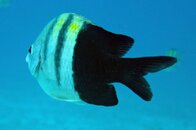Most fish-sergent majors included-can change their colors in response to mood, environment, etc. This is why some fish have different "night" colors than day, and some exhibit breeding colors when mating. Other temporary color changes include those produced by flounder to blend in and the sickly look of many aquarium specimens. This would be my guess. Some fish, I'm thinking of Ulua (Caranx spp.) will turn black when they are the dominant fish in the group. Longnosed butterflyfish (Forcipiger longirostris) are known to turn black especially on the Kona Coast, but again this is only a temporary change. In captivity, a melanistic butterfly goes back to normal color within weeks.
Hybrids are usually the product of two closely related species. Two species of sergent majors here in Hawaii are known to hybridize (Abudefduf vaigiensis and A. abdominalis) but they produce young that look an awful lot like, well, sergent majors. If the two animals are too distantly related (a hamlet and a sergent), the genes don't match up correctly and the eggs are infertile.
I'd guess if you went back, you'd find a bunch of normal fish, but I'd be interested to hear about it either way if you get the chance.
 There was a whole school of sergeant majors around the fish house, including some blue ones, which I understand to be males guarding eggs. But this one poor fish - I swear it is not photoshopped!! Has anyone ever see one like this before? Could it be some variation, or mutant?
There was a whole school of sergeant majors around the fish house, including some blue ones, which I understand to be males guarding eggs. But this one poor fish - I swear it is not photoshopped!! Has anyone ever see one like this before? Could it be some variation, or mutant?




